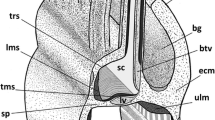Summary
The cuticle of Triops cancriformis consists of endo-, exo- and epicuticle. The epicuticle comprises 4 layers, the epocuticle 10 and the endocuticle 60–80 layers. The layers of the endocuticle consist of microfibrils. These microfibrils are almost parallel to the surface of the cuticle and merge into lamellulae. These lamellulae run vertical to the surface. The lamellulae in any one layer are at right angles to the lamellulae in the neighbouring layers. Thus, some of the fibrils in sensory setae are parallel to the longitudinal axis and others are perpendicular to it.
Polysaccharides are found in the lamellulae, in two layers of the epicuticle, in the attachment regions and in the glycogen deposits in the epidermis cells.
The molting process seems to be similar to the molting process of other arthropoda.
Zusammenfassung
Die Cuticula von Triops cancriformis besteht aus Endo-, Exo- und Epicuticula. Die Epicuticula ist aus vier Schichten aufgebaut, die Exocuticula aus 10 und die Endocuticula aus 60–80. Die Schichten der Endocuticula sind aus annähernd oberflächenparallel verlaufenden Mikrofibrillen, die zu Lamellulae zusammentreten, gebildet. Diese Lamellulae atehen senkrecht zur Oberfläche. Die Lamellulae der einzelnen Lagen verlaufen im rechten Winkel zu denen der Nachbarlagen. In Sinnesborsten verläuft so ein Teil der Fibrillen in Längsrichtung, der andere quer zur Längsachse.
Polysaccharide finden sich in den Lamellulae, in zwei Schichten der Epicuticula, den Desmosomen und als Glykogengranula in Epidermiszellen.
Die Häutung zeigt anscheinend keine Besonderheiten gegenüber anderen Arthropoden.
Similar content being viewed by others
Literatur
Barth, F. G.: Die Feinstruktur des Spinneninteguments II. Die räumliche Anordnung der Mikrofasern in der lamellierten Cuticula und ihre Beziehung zur Gestalt der Porenkanäle (Cupiennius salei Keys., adult, häutungsfern, Tarsus). Z. Zellforsch. 104, 87–106 (1970).
Bergquist, H.: Kutikula-Bildung bei Homarus-Embryonen, eine elektronenmikroskopische Studie. Erg. Heft, Anat. Anz. 111, 348–362 (1962).
Bouligand, Y.: Sur une architecture torsadée repandué dans de nombreuses cuticules d'arthropodes. C. R. Acad. Sci. (Paris) D 261, 3665–3668 (1965).
Delachambre, J.: Etudes sur l'épicuticule des insectes II. Modifications de l'épiderme au cours de la sécretion de l'épicuticule imaginale chez Tenebrio molitor L. Z. Zellforsch. 112, 97–119 (1971).
Gnatzy, W.: Struktur und Entwicklung des Integuments und der Oenocyten von Culex pipiens L. (Dipt.). Z. Zellforsch. 110, 401–443 (1970).
Kawaguti, S., Ikemoto, N.: Electron microscopy of the integumental structure and its calcification process during molting in a crayfish. Biol. J. Okayama Univ. 8, 43–58 (1962).
Kümmel, G., Claasen, H., Keller, R.: Zur Feinstruktur von Cuticula und Epidermis beim Flußkrebs Orconectes limosus während eines Häutungszyklus. Z. Zellforsch. 109, 517–551 (1970).
Gouin, F. J.: Morphologie, Histologie und Entwicklungsgeschichte der Insekten und der Myriapoden VI. Cuticula; Basalmembran; Binde-, Hüll- und Stützgewebe. Fortschr. Zool. 20, 94–111 (1970).
Locke, M.: The structure and formation of the cuticulin layer in the epicuticule of an insect, Calpodes ethlius (Lepidoptera, Hesperiidae). J. Morph. 118, 461–494 (1966).
Neville, A. C.: Chitin orientation in cuticle and its control. Advances in Insect Physiology. 4, 213–286 (1967).
Peters, W.: Elektronenmikroskopische Untersuchungen an chitinhaltigen Strukturen. Verh. dtsch. zool. Ges. 31, 681–695 (1967).
Peters, W.: Vergleichende Untersuchungen der Feinstruktur peritrophischer Membranen von Insekten. Z. Morph. Tiere 64, 21–58 (1969).
Richter, I. E.: Zum Feinbau der Cuticula von Limulus polyphemus L. (Chelicerata, Xiphosura). I. Rasterelektronenmikroskopische Untersuchungen an der Exuvie. Z. Morph. Tiere 68, 85–94 (1969).
Rieder, N.: Ultrastruktur der Carapaxcuticula von Triops cancriformis Bose. (Notostraca, Crustacea). Z. Naturforsch. 27b, 579 (1972).
Smith, D. S.: Insect cells, their structure and function, p. 1–31. Edinburgh: Oliver & Boyd 1968.
Thiéry, J. P.: Mise en évidence des polysaccharides sur coupes fines en microscopic électronique. J. Microscopic 6, 987–1018 (1967).
Author information
Authors and Affiliations
Rights and permissions
About this article
Cite this article
Rieder, N. Ultrastruktur und polysaccharidanteile der cuticula von Triops cancriformis Bosc. (Crustacea, Notostraca) während der Häutungsvorbereitung. Z. Morph. Tiere 73, 361–380 (1972). https://doi.org/10.1007/BF00391929
Received:
Issue Date:
DOI: https://doi.org/10.1007/BF00391929




